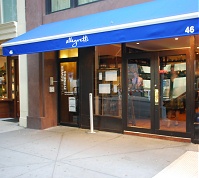Allegretti

Contact Info:
Address: 46 West 22nd Street
City: New York, NY
Zip: 10010
map: View the Map
Phone: (212) 206-0555
Website: http://www.allegrettinyc.com/
Hours: Mon-Sat, 5-11pm
Food Info:
Menu: View the Menu
Chef:
Alain Allegretti
Cuisine:
French
Payment:
Amex Visa Mastercard Discover
Cititour Review:
Let me ask you a question. Are there any circumstances under which you’d be willing to pay $19 for an heirloom tomato salad? What about $38 for a piece of halibut? If you’re thinking “No thanks, buddy,” let me add a few more details to the picture. What if I told you that the tomatoes tasted as though they were just pulled from the vine in the warm sun and that they were served with creamy burrata cheese, and drizzled with extra virgin olive oil and decorated with fresh basil? And what if I told you that the halibut was luscious and milky, capped with a crisp and smoky top hat of pancetta, with a saffron-scented risotto paella cake all set in a spicy tomato sauce? And what if I told you that these dishes were served in a serene little jewel-box of a restaurant that offered wonderful hospitality? Would this be something you might be interested in? Yes? Well, if so, get on the phone and call Allegretti, Alain Allegretti’s lovely namesake Nicoise eatery, right now.
If not, I can certainly understand. With the economy in a tailspin, and what seems like a city-wide yen for simpler, cheaper times—a nice cold pint or a glass of table wine and some rustic local home cooking—the idea of dropping that kind of cash on tomatoes and fish is a tough one to swallow. Similarly, the decision to open an expensive restaurant on a lonely, construction-blocked stretch of 22nd Street just off of 6th Avenue is a curious one. Nonetheless, this is precisely what the acclaimed chef Alain Allegretti has done with his restaurant, a serene and pretty space that appears like a Tiffany’s box at the end of 22nd Street, in view of the Staples on the Avenue.
While the location might not be ideal, it’s hard not to like the place. It’s washed in white and filled with intimate tables dressed in soft linens and fine stemware, with floors of glossy wood, and a small modern bar and lounge with rich leather loveseats and chairs, like the sitting area in a posh hotel room. The menu, too, is precious and elegant, not to mention expensive—apps come in between $12 and $20, entrees range from $25-$38 and most wines over $75. It’s as if to say to the world, “To hell with the economy!” I am not sure that’s a wise tact to take, but it’s one that seems to be working for Allegretti. The place has been busy on the few times I have been in, with festive tables of Chelsea boys and their Cosmos, pretty women dressed up for a night out with the girls, and handsome older couples in sets of four interspersed with younger pairs of two of the Thrillist/Daily Candy set.
The happy crowds are a testament to the quality of the food and the exemplary and hospitable service. It’s the sort of place you’ll want to return to, again and again even though the price point may make that challenging.
Precise and delicate, the food at Allegretti, a chef from Nice who wanted to open a restaurant that embraced the cuisine of his hometown. I’m not sure that the local beach spots are serving food quite this exquisite (or expensive), but then again, I don’t know how many of Nice’s local chefs have cooked with Alain Ducasse, Alain Chapel and Jacques Maximin.
So yes, the food is impressive. When Jamie, Susie, Adrienne and I had dinner there a few weeks ago, we were wildly impressed. It’s clear that Allegretti is not messing around. He’s ambitious and talented, which, when it comes to opening restaurants (and pretty much everything else in life) is a good combination.
While the menu is divided between starters, meats and fish, one of my favorite courses were the pastas. The Nicois Ravioli ($20)—circular dumplings the size of small whoopee pies are plumped up with braised oxtail, Swiss chard and parmesan—were rich and heavenly, plated in a wildly flavorful beef jus. The potato gnocchi were also outrageously good. Notched with the side of a fork, they were creamy and light, almost like they were made from mascarpone, not potatoes. They’re tucked into a spicy lamb ragout with baby artichokes and topped with pecorino cheese ($20). The Carnaroli risotto ($18) Jamie and I shared at the bar on another night was also exquisite—cooked gently with green peas, zucchini blossoms, and fresh and tangy goat cheese that added a wonderful brightness to the rice. You could easily just eat pasta here and be quite content.
But then you’d miss out on the Perugina sausages ($14)—fat and blistered, nestled in a Basque-like ragout of caramelized onions and sweet peppers, with little crispy panisses the shape of checkers. These sausages have been ordered on all of my visits, and I’d like to suggest that they find their way inside a crusty baguette, along with that sweet pepper and onion ragout. If so, this might be the greatest sandwich ever. Sausage and peppers eat your heart out.
An appetizer of octopus cooked on the plancha was also excellent ($17)—tender but pleasantly chewy, served over a clever salad of green apple, celery, red onion, potatoes and arugula, dressed in a yin-yang vinaigrette made from sherry and honey. But a simple green salad of baby lettuces with radish, cherry tomato and ricotta salata ($12), was not working. What a surprise, but the radishes were overly pickled, giving the salad an unpleasant excessive vinegary acidity.
While we recapped the horror show that was the Republican convention (Adrienne was practically apoplectic), we moved on to our entrees. The Atlantic Halibut, which I spoke of earlier, was among the most expensive dishes on the menu ($38), but it was also one of the most delicious pieces of fish I’ve ever had. The milk-fed veal ($36) was also impressive—tender to the point of absurdity (did I even need a knife?) with an medley of oven-confited tomatoes, zucchini, and eggplant so concentrated with sweetness that this vegetable tart would have been suitable for dessert.
Worth mentioning is also the bread, made by Alain’s friend chef Iacapo Falai (Falai, Caffé Falai, and Panneteria)—snug little warm rolls filled with black olive, pesto, or just plain. They disappear quickly but empty bread plates are refreshed with regularity.
Desserts ($10) are also very good, in particular any of the house made gelatos and sorbets, and the grappa flourless chocolate fondant that somehow tastes light even though it’s pure chocolate.
And now we come to the conundrum. While I’d love to return to Allegretti, I don’t know that I can risk not being able to pay my rent for a meal there. And that’s a shame because I really liked this restaurant (especially those sausages and that risotto). The food is very thoughtful, many courses stood out as truly exceptional. I am torn because I feel like restaurants in this town are in a tough position. Chefs with whom I have spoken over the past few months in particular have been burdened by rising food costs (as much as 30% over last year) and are put between a rock and a hard place. Do they compromise ingredient quality and portion size and lower prices, or keep prices high and risk losing business? Clearly Allegretti has chosen the latter, and I can’t say I blame him, but I do wonder how it will play out. I guess we’ll wait and see. But I can tell you this. A Perugina sausage and peppers sandwich is definitely something I’d be interested in.
Review By: Andrea Strong
Location:


